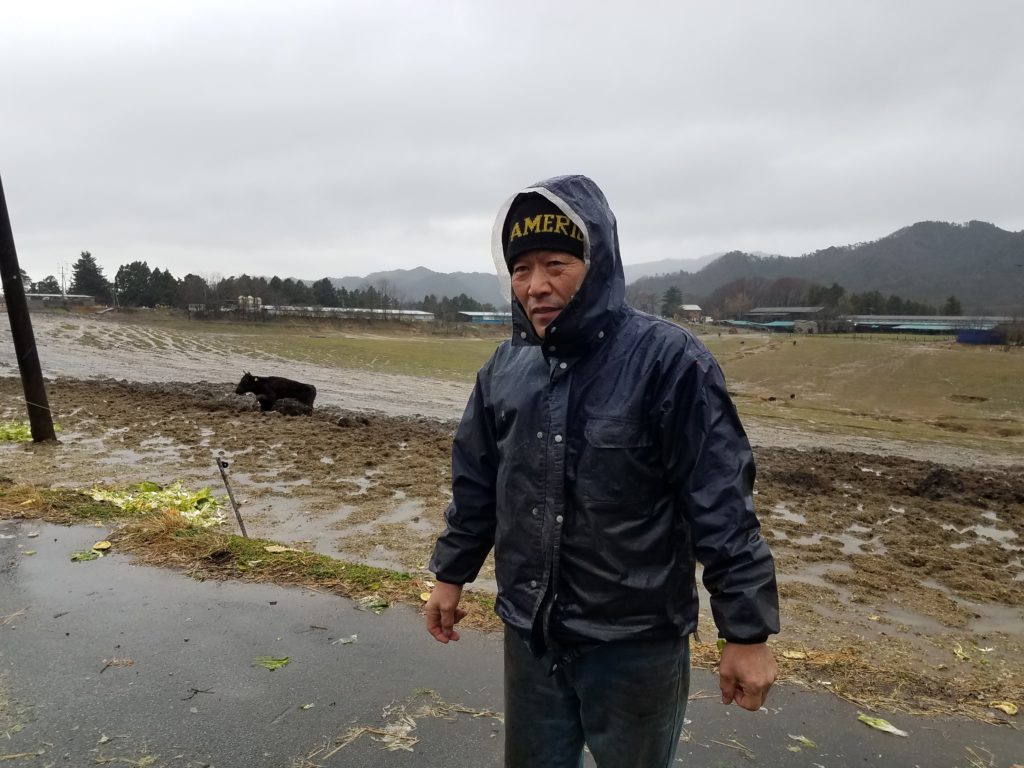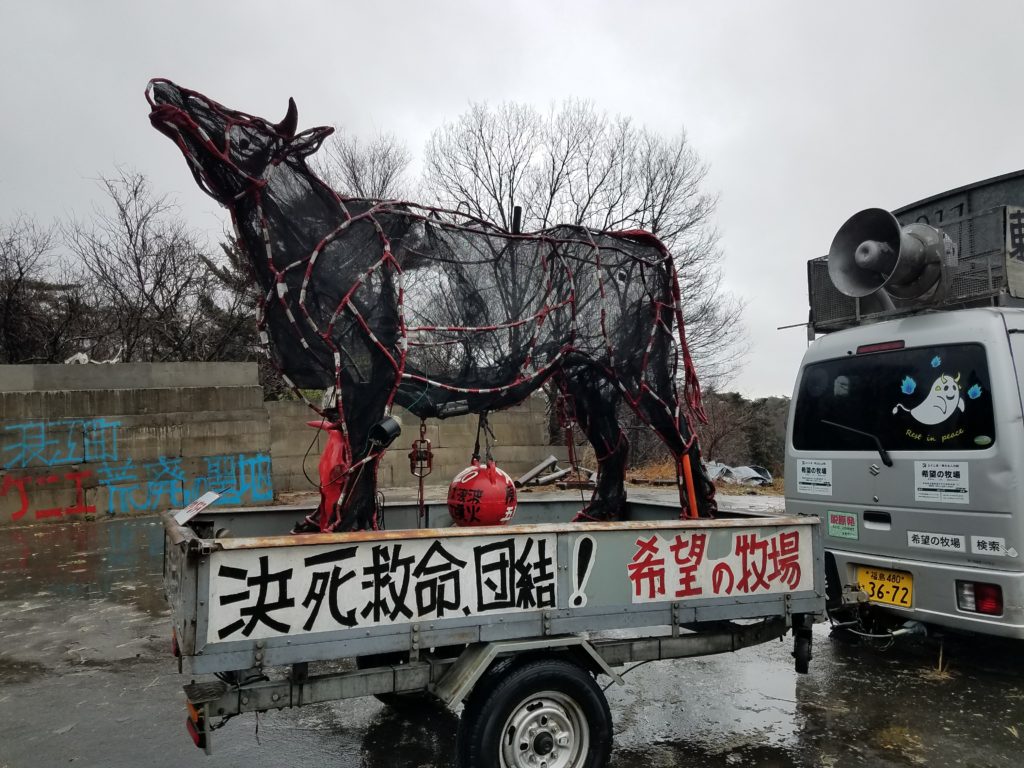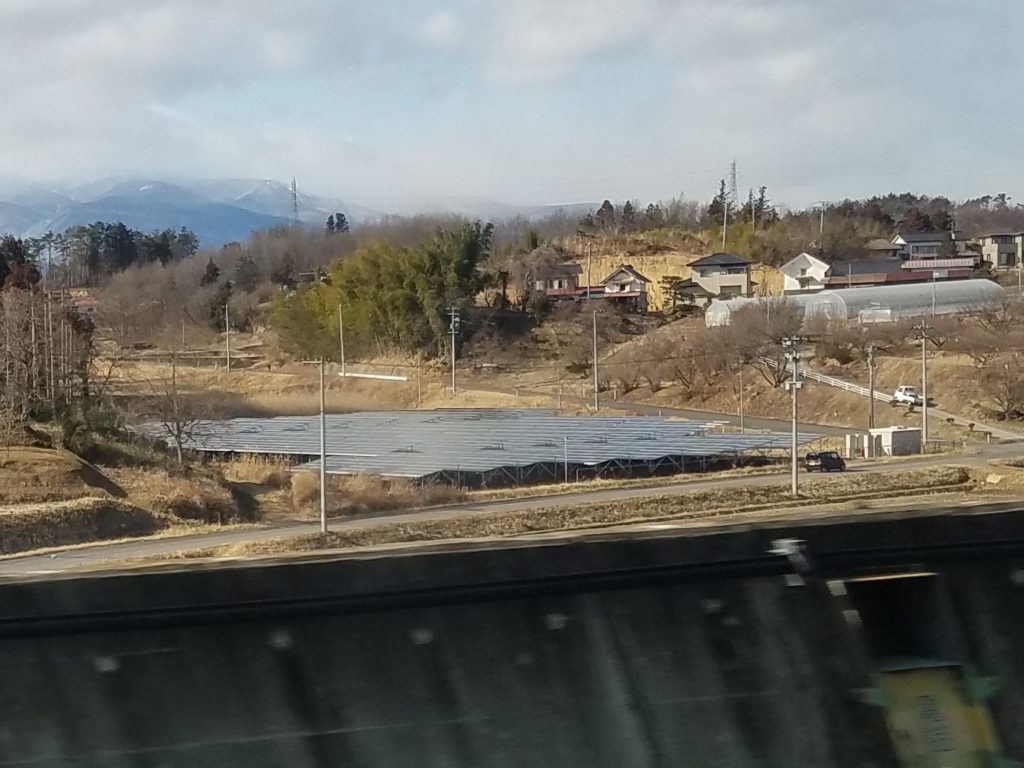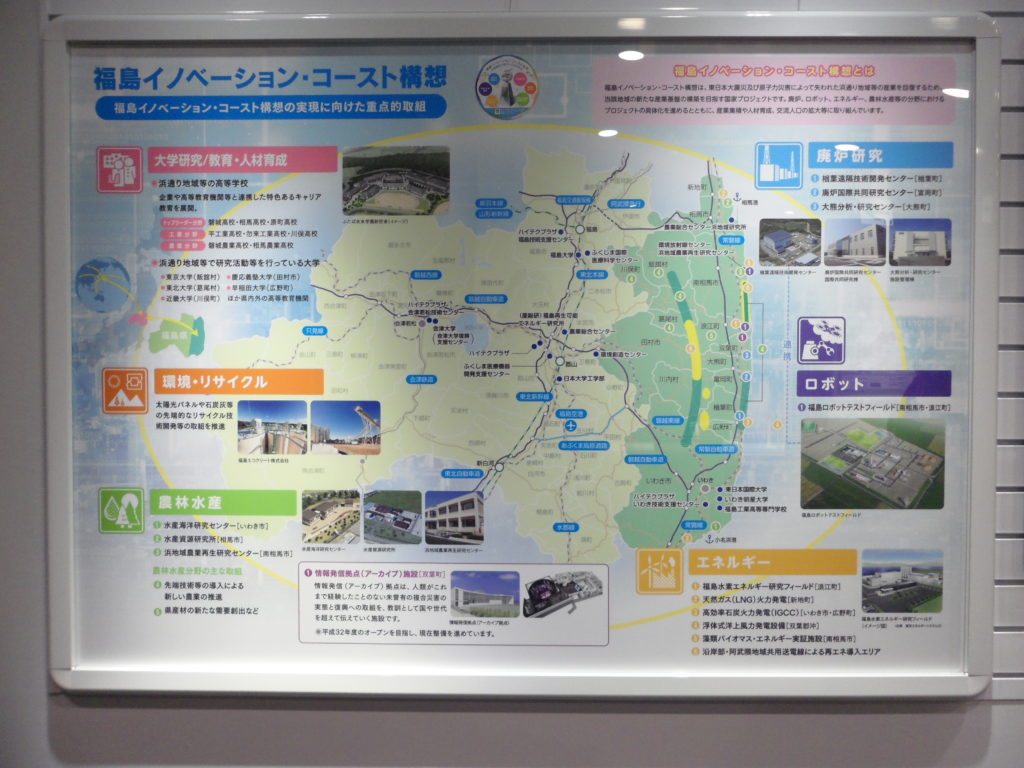Part 6 – The Economy
Fukushima is farming country, and contamination from the Daiichi power plant severely damaged the agricultural industry across the whole prefecture. Whether or not a farm was actually exposed to radioactive contamination, the name Fukushima has a stigma, and some people are still hesitant to eat food from there. Even as we traveled to Japan this past January, countries were debating whether or not Fukushima-grown food should be served at the upcoming Tokyo Olympics. Although Japan’s safety limits for radioactivity in food are set at one tenth the maximum levels of the United States and European Union, skeptics (particularly China and South Korea) question the objectivity of the Japanese government’s testing procedures.[1]
Such skepticism from outside parties continues to affect Fukushima’s economy. Any farms within the evacuation zone understandably lost their crops and the utility of their land (and therefore income) until cleanup efforts were underway. Residents from the mandatory evacuation zones have received financial support from the government for up to one year after their homes are decontaminated. During this time, these evacuees have been deciding whether to demolish their homes and settle elsewhere, return and try to pick up their lives, or return and shift their line of work entirely. In the latter case, it is a difficult process (economically and emotionally) to abandon a vocation that has in many cases been part of one’s family for generations.
I have mentioned before that the experience we had on our tour was a very balanced one. In my opinion, Japan Wonder Travel[2] did a good job of arranging meetings with individuals and organizations that had a wide variety of perspectives about what happened and where Fukushima is headed. While there was some small amount of public relations spin from more official sources, what we heard from some of the residents was in no way sanitized. The strongest opinions we heard were from a cattle rancher who was (understandably) the most outspoken Japanese person I have ever met.

Kibo no Bokujo, “The Farm of Hope”
While the loss of crops is tragic for any farming family, hearing about what happened in the case of farmers responsible for animals made me cry – in public – which is not something that happens in Japan. If the subject of animal suffering upsets you, consider this your content warning.
One of the last stops on our tour was to meet Yoshizawa Masami, who calls himself The Cowboy and is charge of a cattle herd in Namie, the town that was hardest-hit by contamination after the accident. He told us that during the evacuation, humans were ordered to leave, but farm animals had to be left in place, as there was no feasible way to evacuate all of them too. Farmers were not allowed back in to take care of their animals, and therefore many animals who could not escape their farms and forage on their own starved to death. He showed us graphic pictures of skeletal cows that were found dead with their heads in their feed troughs. When farmers were finally allowed back in during the summer of 2011, they were ordered to kill any animals left living because the animals were contaminated and could not be sold for food.
Some 1,800 cows were killed in Fukushima after farmers returned, but Yoshizawa-san refused to comply. Although he was raising the cows for slaughter before the accident, he did not agree with the government’s orders that he should initially let them starve or later kill them. In fact, while the evacuation order was in place he regularly snuck across police barricades to take food to his cows. After the evacuation order was lifted, he actively protested the government’s animal kill order. His position then and now is that he is a cowboy, and therefore responsible for the animals in his care: “These are our animals, not commodities,” he told us.
He still has 260 cows on his farm, some of which were originally his, and some of which he found escaped from other farms. These cows cannot be killed for beef, so he is letting them live out the natural course of their lives. Beef cows are typically slaughtered at around 30 months of age; these cows are now around 12 years old and will probably live to about 15. The cowboy believes they may live up to 20 because the are happy and cared for. He hopes to keep them alive as long as he can as a symbol of protest “for cows, ourselves, the future of our country, our children, and the environment.” His defiance has made him a thorn in the government’s side, but also given him an international reputation, having appeared in interviews with a number of news sources, including the New York Times.[3]

The Cowboy has no way of generating revenue from the farm, but his new mission is to protest nuclear energy, human contribution to climate change, and ongoing discrimination against all things Fukushima, especially her evacuees. Yoshizawa-san has led over 150 demonstrations at the Shibuya Scramble Crossing in Tokyo (you’ve seen pictures of it, whether you know it or not)[4] and was involved in helping to halt the construction of Fukushima Daisan (Number Three) in Namie. There is a published book about local residents’ efforts to stop the area’s third nuclear plant, and an illustrated children’s book about the story of the farm (I left with a copy).[5] Because of this reputation, he receives donations of money and produce to keep things running in the absence of revenue sources.
He has tried to bring in researchers to study the cows so we can better understand the kind of impacts radiation exposure and contamination have on animals, saying that it is the responsibility of the state to pursue these investigations. Apparently multiple ministries passed the buck: the Ministries of Agriculture, Energy, and Education each said it was another’s responsibility. Any studies that have been completed trying to tie bovine abnormalities to the accident at Daiichi have come back as inconclusive. He believes that finding a correlation would not benefit anyone conducting said studies and would only go on to damage the industry further, so it behooves the government to steer clear of any in-depth investigations or iron-clad results demonstrating a relationship.
Yoshizawa-san understands how much of the local economy was supported by Daiichi and Daini. He said that we are addicted to energy, and that working in power generation was a way of life for Fukushima, as “the colony that provides power to Tokyo.” He knows that the issue is a complex one, and that while the reactors at Daiichi were old and not designed to withstand an earthquake and tsunami of that magnitude, getting rid of nuclear altogether is the best course of action for future generations. He went on to say that nuclear cannot be replaced with fossil fuels like coal: Japan’s coal supply comes largely from Australia, which was in flames at the time, a result of climate change, which is created in part by burning coal.
Industrial Shift
During the tour, several residents told us that while nuclear energy generation was the basis for the local economy for forty years, nuclear accident cleanup will be for the next forty years. Some farmers have successfully started back up in decontaminated areas, growing fruits, vegetables, or rice. Other farmers have shifted operations, such as one man in Namie who was producing food, but is now growing flowers (and getting an excellent price for his Texas Bluebells). Finally, some farms have switched entirely from harvesting rice to harvesting solar energy, renting their fields out to host rows of solar PV (photo-voltaic) panels.

(Not a bad photo from a 200mph bullet train.)
In an optimistic spin on the rebuilding efforts, the Ministry of Economy, Trade, and Industry is supporting a policy initiative called the “Fukushima Innovation Coast.” The idea is to promote Fukushima’s image as a place for research and development in the areas of nuclear decommissioning, renewable energy, agriculture, and robotics.[6] Towns throughout the coastal area are hosting a variety of projects in these fields, and the region holds regular symposiums to share knowledge and highlight regional advancement. The goal is to achieve 100% renewable energy in the area by 2040.[7]
Businesses outside the scope of the Fukushima Innovation Coast are working to reopen as well. Our overnight stay during the tour was at J-Village, a training facility for Japan’s national soccer teams. It was converted to a disaster relief station after the tsunami and has recently reopened to guests and soccer teams (amateur and professional alike) who wish to use the facilities.[8]
J-Village was thrilled to be the starting point of the 2020 Olympic torch relay in Japan, after which the torch would pass through all 47 prefectural capitals on its way to the stadium in Tokyo. Indeed, the idea behind bringing the torch to several Fukushima landmarks was to highlight the recovery that has taken place over the last nine years. However, even as we were there in January, Greenpeace was voicing opposition to the torch’s route through coastal Fukushima because of residual radiation levels.[9] More devastating than bad publicity from Greenpeace, however, was the decision to delay the 2020 Olympics one year because of the novel coronavirus. The Olympic flame will be stored and displayed in Fukushima until the relay resumes next year.[10]

As we look ahead to the future, technological innovation in energy generation remains a huge question. Can zero-carbon electricity generation happen on the scale we need without nuclear? And if not, is nuclear even an option in the face of so much global opposition since 2011? We will address those questions next week.
Thank you for reading.
[1] https://www.japantimes.co.jp/news/2019/11/26/national/fukushima-food-olympics-tokyo-2020/#.XpHdMOpKipo
[2] https://japanwondertravel.com/
[3] https://www.nytimes.com/2014/01/12/world/asia/defying-japan-rancher-saves-fukushimas-radioactive-cows.html
[4] https://www.gotokyo.org/en/spot/78/index.html
[5] https://www.goodreads.com/book/show/30632063-farm-of-hope
[6] https://www.meti.go.jp/english/press/2019/0123_001.html
[7] https://www.theguardian.com/environment/2020/jan/05/fukushima-unveils-plans-to-become-renewable-energy-hub-japan
[8] https://www.nippon.com/en/guide-to-japan/gu900140/j-village-once-again-a-place-for-soccer-fans.html
[9] https://www.theguardian.com/world/2019/dec/04/radiation-hotspots-found-near-fukushima-olympic-site-greenpeace
[10] https://www.espn.com/olympics/story/_/id/28946033/tokyo-olympics-officially-postponed-2021
0 Comments